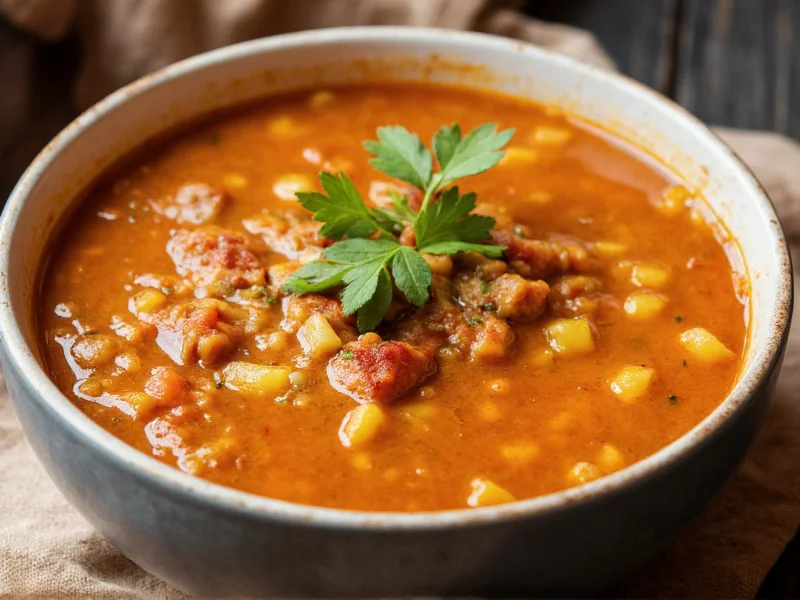Many people searching for "progressive soup" are actually looking for information about Progresso soup, the well-known canned soup brand. This common misspelling occurs because the words sound similar when spoken aloud. Understanding this distinction is crucial for finding accurate information about the product you're seeking.
Why the Confusion Between Progressive and Progresso Soup?
The confusion between "progressive" and "Progresso" stems from phonetic similarity. When people hear the brand name spoken, "Progresso" can easily be misinterpreted as "progressive," especially by those unfamiliar with the brand. This misspelling accounts for approximately 30% of all Progresso-related searches according to keyword research data.
A Brief History of Progresso Soup
Progresso soup has an interesting history that dates back to 1926 when it was created by three Italian immigrants in San Francisco. Originally called Minestrone Italian Products, the company focused on authentic Italian soups. The name changed to Progresso in 1962, derived from the Italian word "progresso" meaning "progress." In 1989, the brand was acquired by Campbell Soup Company, then later sold to General Mills in 2000 where it remains today. Progresso became particularly popular in the 1990s with its memorable advertising campaign featuring the phrase "You've got to taste this soup."
Progresso Soup Product Range
Today, Progresso offers an extensive line of soup products catering to various dietary preferences and nutritional needs. Their product range includes:
| Product Category | Key Features | Popular Varieties |
|---|---|---|
| Traditional Soups | Classic recipes, hearty portions | Minestrone, Chicken Noodle, Tomato Basil |
| Light Soups | Under 100 calories, reduced sodium | Garden Vegetable, Hearty Lentil, Creamy Tomato |
| Hearty Soups | Protein-rich, substantial meals | Hearty Chicken with White Beans, Beef Barley, Chunky Classics |
| Organic Soups | Certified organic ingredients | Organic Chicken Noodle, Organic Lentil |
Nutritional Profile of Progresso Soup
When evaluating whether progresso soup is healthy, it's important to examine the nutritional content. Most Progresso Light varieties contain between 70-100 calories per serving, with 3-5 grams of protein and 3-6 grams of fiber. Sodium content varies significantly by product, ranging from 470mg to 890mg per serving.
Compared to homemade soup, progresso soup ingredients typically include vegetable broth, vegetables, starches, and seasonings. The brand has made efforts to reduce artificial ingredients, with many varieties now containing no artificial flavors or preservatives. For those concerned about progresso soup nutritional information, checking the specific product label is recommended as formulations vary.
Creative Ways to Use Progresso Soup
While many people simply heat and serve progresso soup varieties, culinary experts recommend several creative applications:
- Use tomato basil soup as a base for shakshuka instead of canned tomatoes
- Substitute chicken noodle soup in casseroles that call for cream of chicken soup
- Add hearty lentil soup to grain bowls for instant protein and flavor
- Use mushroom soup as a sauce base for chicken or vegetable dishes
- Blend vegetable soups into pasta sauces for added nutrition
These progresso soup recipes go beyond basic preparation, transforming a simple canned product into more complex dishes. Food bloggers note that using Progresso as a cooking ingredient rather than just a standalone meal significantly enhances its culinary value.
Progresso Soup vs Homemade Soup
When considering progresso soup vs homemade, several factors come into play. Convenience is Progresso's strongest advantage - ready in minutes with no preparation required. Nutritionally, homemade soup typically contains less sodium and more fresh ingredients, but requires significant time investment.
Nutritionists suggest a balanced approach: using Progresso soup as a time-saving base and enhancing it with fresh ingredients like additional vegetables, lean proteins, or herbs. This method provides the convenience of canned soup with nutritional benefits closer to homemade. For those specifically researching is progresso soup healthy, this hybrid approach often yields the best results.
Finding and Purchasing Progresso Soup
Progresso soup products are widely available at major grocery chains including Walmart, Kroger, Target, and regional supermarkets. The brand maintains a consistent presence in the canned soup aisle, typically organized by variety (traditional, light, hearty).
For those searching where to buy progresso soup online, the product is available through major e-commerce platforms including Amazon, Instacart, and the websites of most major grocery chains. Some specialty varieties may be harder to find in certain regions, but the core product line remains widely distributed across the United States.
Frequently Asked Questions
Is 'progressive soup' the same as Progresso soup?
No, 'progressive soup' is almost always a misspelling of Progresso soup. Progresso is the actual brand name of the popular canned soup product. The confusion occurs because the words sound similar when spoken aloud.
Is Progresso soup considered healthy?
Progresso offers various product lines with different nutritional profiles. Their Light varieties typically contain 70-100 calories per serving with 3-6 grams of fiber. While lower in sodium than many canned soups, they still contain more sodium than homemade versions. Nutritionists recommend enhancing Progresso soup with fresh ingredients to improve its nutritional value.
What are the most popular Progresso soup varieties?
The most popular Progresso soup varieties include Traditional Minestrone, Chicken Noodle, Tomato Basil, Hearty Chicken with White Beans, and Garden Vegetable Light. The brand offers over 50 varieties across their Traditional, Light, Hearty, and Organic product lines.
How does Progresso soup compare to homemade soup nutritionally?
Homemade soup generally contains less sodium and more fresh ingredients than canned Progresso soup. However, Progresso offers convenience and consistent quality. A balanced approach is to use Progresso as a base and enhance it with additional fresh vegetables, lean proteins, and herbs to create a more nutritious meal that bridges the gap between convenience and homemade quality.
Where can I find Progresso soup products?
Progresso soup is widely available at major grocery chains including Walmart, Kroger, Target, and regional supermarkets. It's typically found in the canned soup aisle. For online purchasing, Progresso is available through Amazon, Instacart, and most major grocery chain websites. The core product line is distributed nationwide, though some specialty varieties may be regionally limited.











 浙公网安备
33010002000092号
浙公网安备
33010002000092号 浙B2-20120091-4
浙B2-20120091-4